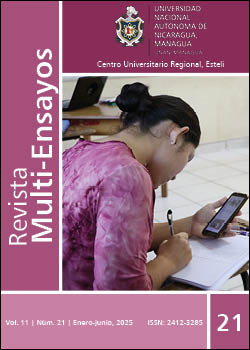The challenges of learning polynomial and linear algebra in mathematics majors
DOI:
https://doi.org/10.5377/multiensayos.v11i21.20081Keywords:
Algebra, learning, Mathematics, linear, polynomialAbstract
Polynomial and linear algebra are fundamental components in the education of mathematics students. These branches of algebra provide the necessary basis for the development of analytical, abstract skills, and are essential for understanding the approach to more complex mathematical problems, in which logical-scientific reasoning is required. However, learning polynomial and linear algebra poses a number of challenges that students must face, ranging from understanding in conjunction with problem solving to analytical demonstrations. The purpose of this essay is to describe some of the most common obstacles that arise during the learning process and discuss the importance of addressing them effectively, taking as reference the groups of II and IV year of Mathematics, during the first semester 2023 at the Regional University Center of Estelí (CUR-Estelí) of the UNAN-Managua.
Downloads
References
Abbott, J., y Bigatti, A. M. (2014). What is new in CoCoA? [¿Qué hay de nuevo en CoCoA?]. Software matemático – ICMS 2014: 4to Congreso Internacional, Seúl, Corea del Sur. https://www.academia.edu/download/66628827/What_is_new_in_CoCoA20210423-9254-1xlpnz2.pdf
Aké Tec, L. P., y Larios Osorio, V. (2020). Competencia algebraica de profesores de matemáticas. IE Revista de Investigación Educativa de la REDIECH , 22(1), 512-531. http://dx.doi.org/10.23925/1983-3156.2020v22i1p512-531
Báez, N., Heredia, W., y Pérez, O. (2017). El movimiento de la variable en el cálculo diferencial: orientaciones didácticas. Revista Transformación, 13(3), 444-455. http://scielo.sld.cu/pdf/trf/v13n3/trf11317.pdf
Barreto García, J. (2023). Completación de cuadrados y cubos en la deducción geométrica algebraica. UNIÓN- Revista Iberoamericana de Educación Matemática(69), 1-19. https://union.fespm.es/index.php/UNION/article/view/1543
Cevallos Santacruz, J. C. (2021). Microlearning como estrategia de apoyo en el proceso de enseñanza-aprendizaje de álgebra en noveno año E.G.B. de la unidad educativa “Sumak Yachana Wasi” Cotacachi. [Tesis de maestría]. Universidad Técnica del Norte. http://repositorio.utn.edu.ec/handle/123456789/11671
Dorier, J. L. (2016). Duality between formalism and meaning in the learning of linear algebra [Dualidad entre formalismo y significado del álgebra lineal]. En Didactics of mathematics in higher education as a scientific discipline. Kluwer Academic Publishers. https://archive-ouverte.unige.ch/unige:85576
Dorier, J. L., y Sierpinska, A. (2001). Research into the teaching and learning of Linear Algebra [Investigación sobre la enseñanza y aprendizaje del Álgebra Lineal]. En D. Holton, M. Artigue, U. Kirchgräber, J. Hillel, M. Niss, y A. Schoenfeld (Edits.), The teaching and learning of mathematics at university level [La enseñanza y aprendizaje de las Matemáticas a Nivel Universitario] (pp. 255-273). Kluwer Academic Publishers. https://link.springer.com/chapter/10.1007/0-306-47231-7_24
Fadil, A., y Puig, L. (2014). Demostraciones algebraicas de las ecuaciones cuadráticas en Sharḥ al-urjūza al-yāsmīniyya de Ibn al-Hā’im. Sociedad Española de Investigación en Educación Matemática (SEIEM). http://funes.uniandes.edu.co/5324/
León Loaiza, M. A., y León Loaiza, J. R. (2023). Aprender álgebra lineal con metodologías innovadoras y herramientas interactivas aplicado a problemas de la vida cotidiana. LATAM Revista Latinoamericana de Ciencias Sociales y Humanidades, 4(2), 2555-2562. https://doi.org/10.56712/latam.v4i2.777
Lins, R., y Kaput, J. (2004). The early development of algebraic reasoning: The current state of the field [El desarrollo temprano del razonamiento algebraico: el estado actual del campo]. En K. Stacey, H. Chick, y M. Kendal (Edits.), The future of the teaching and learning of algebra. The 12th International Conference on Mathematics Instruction [El futuro de la enseñanza y aprendizaje del álgebra. La 12a conferencia internacional sobre instrucción de matemáticas] (pp. 47-70). Norwood, MA: Kluwer Academic Publishers. https://link.springer.com/chapter/10.1007/1-4020-8131-6_4
Martín, A., y Pérez, O. (2019). Las ciencias básicas en la formación del ingeniero: el caso del Álgebra Lineal. Revista Estudios Generales UNAPEC, 2(4), 31-38. https://repositorio.unapec.edu.do/handle/123456789/792
Martínez Suárez, M. D., y Romero Díaz, T. (2019). Transición de la aritmética al álgebra: Un estudio con estudiantes universitarios de Nicaragua. Revista Electrónica De Conocimientos, Saberes Y Prácticas, 2(2), 29-39. https://doi.org/10.5377/recsp.v2i2.9297
Osorio Vidal, V. G., Palomino Alca, J. T., Huayhua Prada, M. F., y Gambini López, I. (2023). Enseñanza del Álgebra Lineal en estudiantes universitarios. Horizontes. Revista de Investigación en Ciencias de la Educación, 7(27), 380 - 387. https://doi.org/10.33996/revistahorizontes.v7i27.522
Parrilla Rivera, G., Selva Useda, M. M., y Velásquez Benavidez, J. A. (2016). Programa de Asignatura Álgebra Lineal. Universidad Nacional Autónoma de Nicaragua.
Pérez González, O. L. (2020). La Formación y Desarrollo Conceptual en el Cálculo Diferencial y el Álgebra Lineal en las Carreras de Ingeniería. Revista Paradigma, 41, 571 – 599. http://funes.uniandes.edu.co/22278/
Rendón, S., y Hoyos, O. (2016). La ausencia de dominio conceptual de las propiedades algebraicas de la potenciación, evidenciada en la notación matemática. Tesis de Grado. Universidad de Antioquia | Facultad de Educación. https://bibliotecadigital.udea.edu.co/dspace/handle/10495/28341
UNAN- Managua. (2016). Programa de Asignatura de Algebra Lineal. Facultad de Educacion e Idiomas.
UNAN-Managua. (2021). Documento Curricular de la Carrera de Matemáticas. UNAN-Managua, Facultad de Educación e Idiomas .
Zazkis, R., y Liljedahl, P. (2002). Generalization of patterns: The tension between algebraic thinking and algebraic notation [Generalización de patrones: La tensión entre pensamiento algebraico y notación algebraica]. Educational Studies in Mathematics, 49(3), 379-402. http://dx.doi.org/10.1023/A:1020291317178

